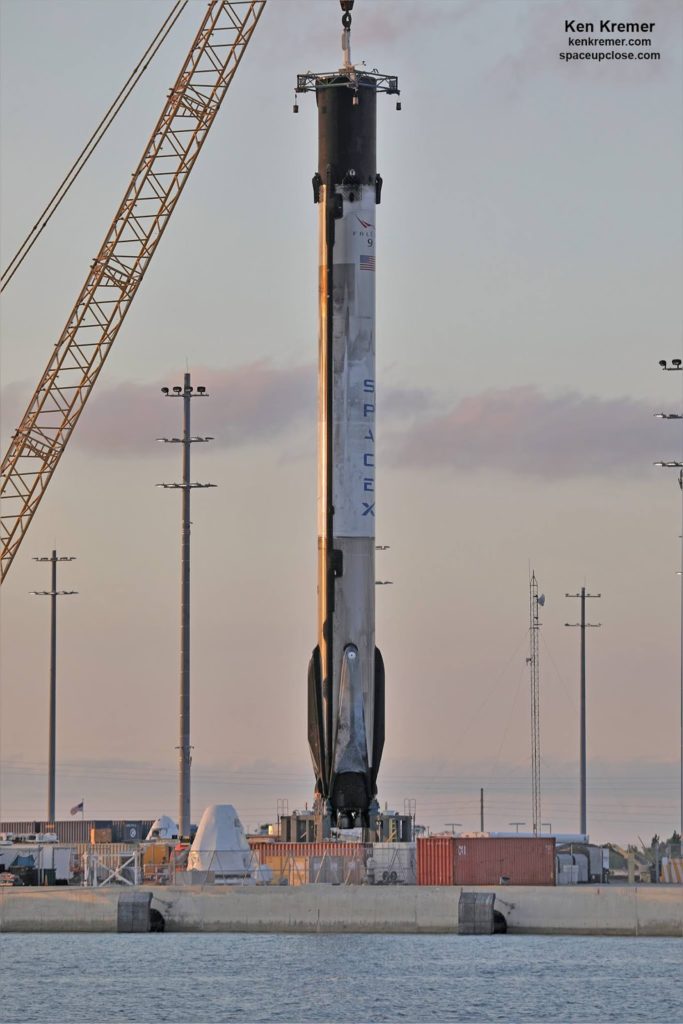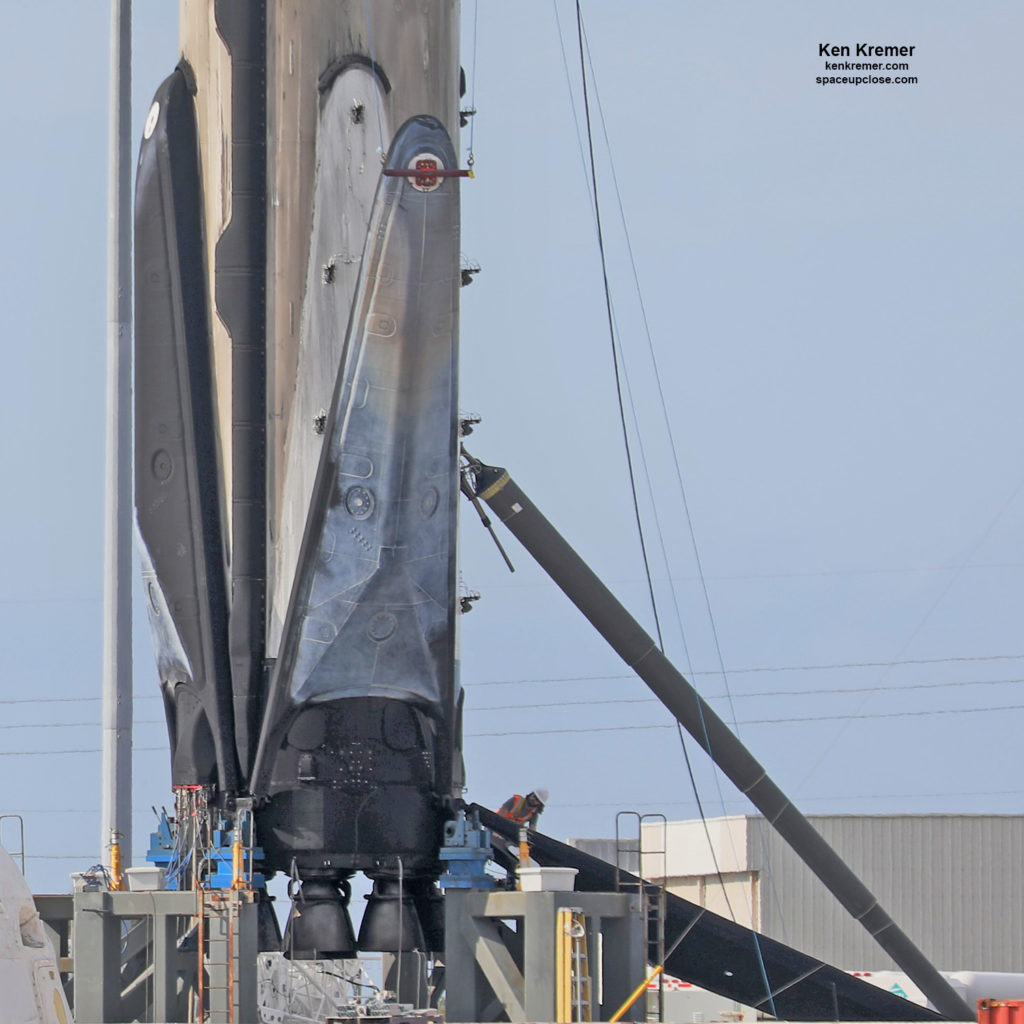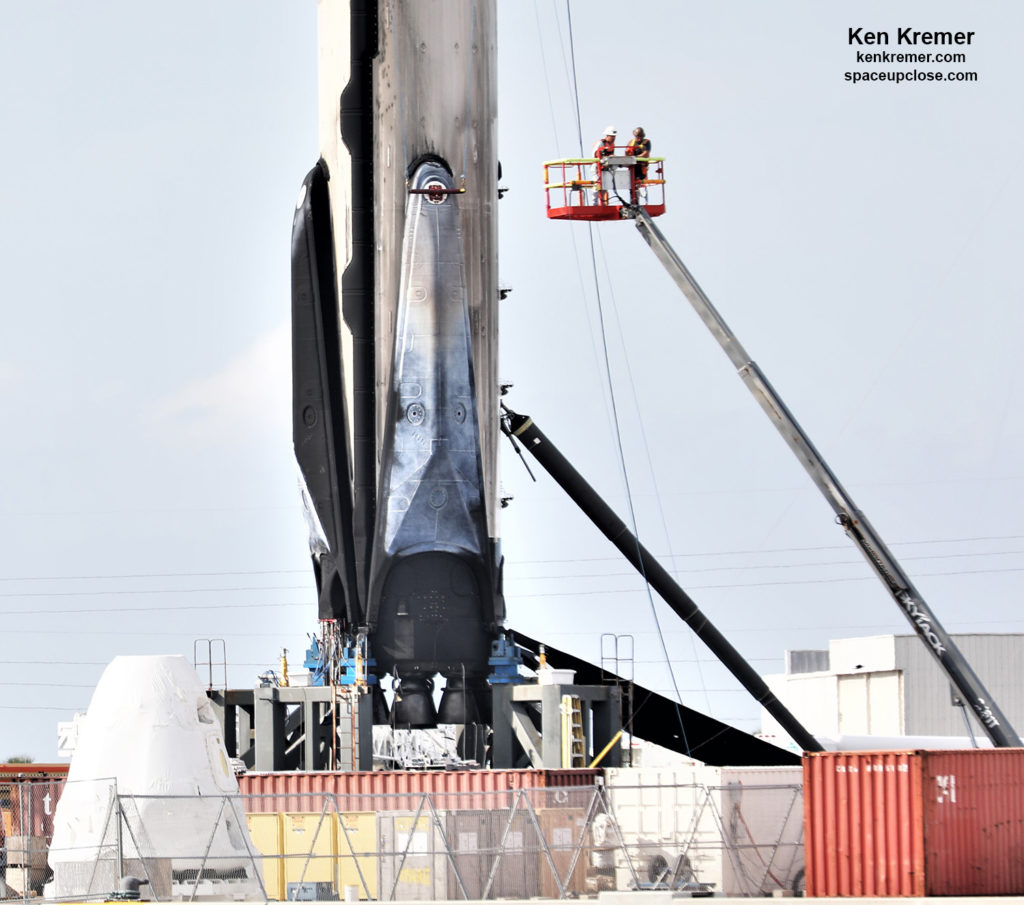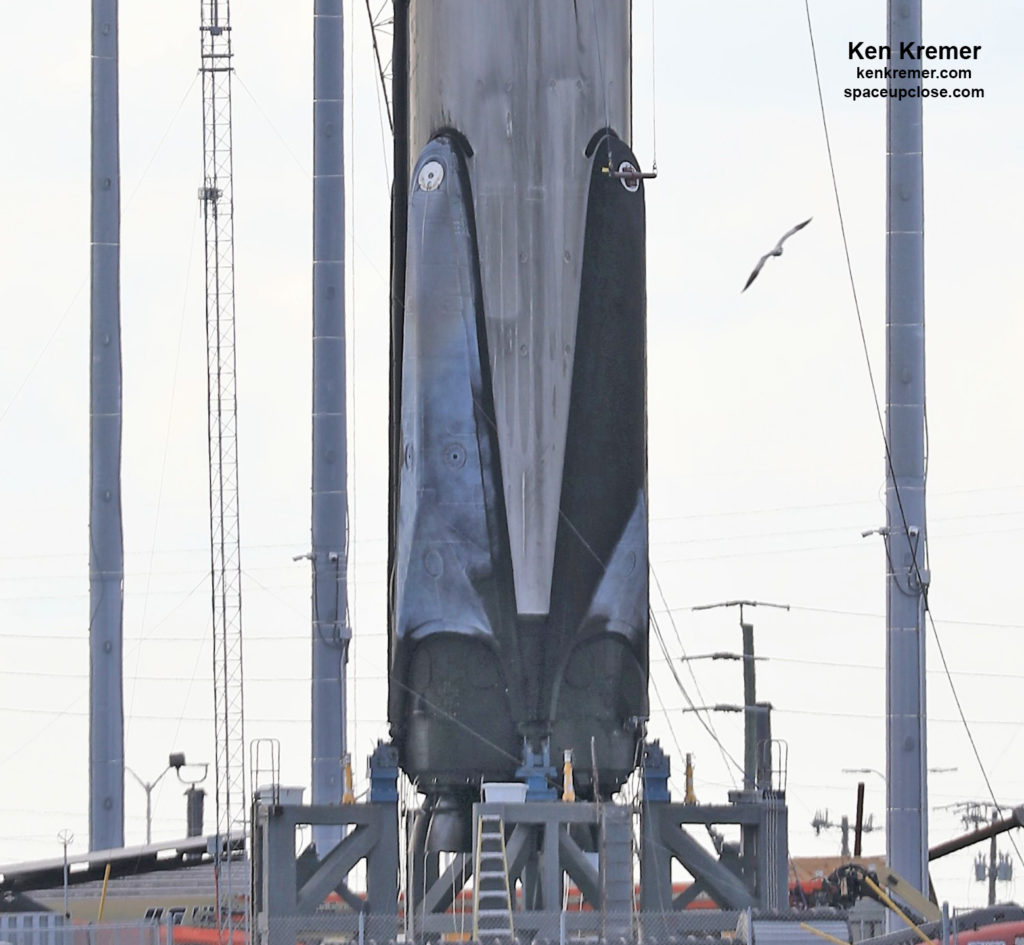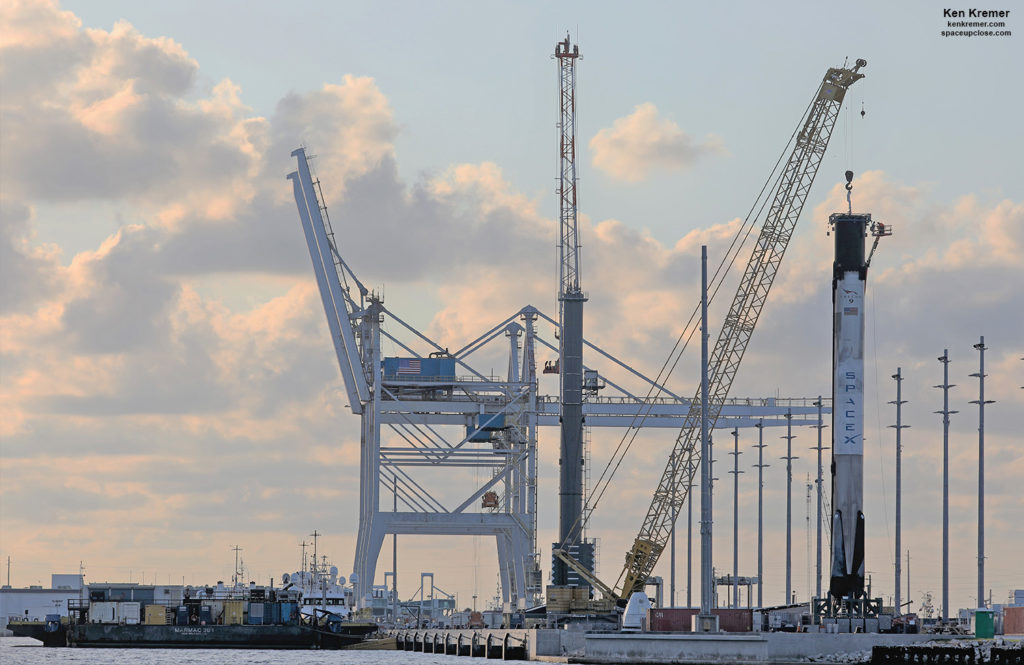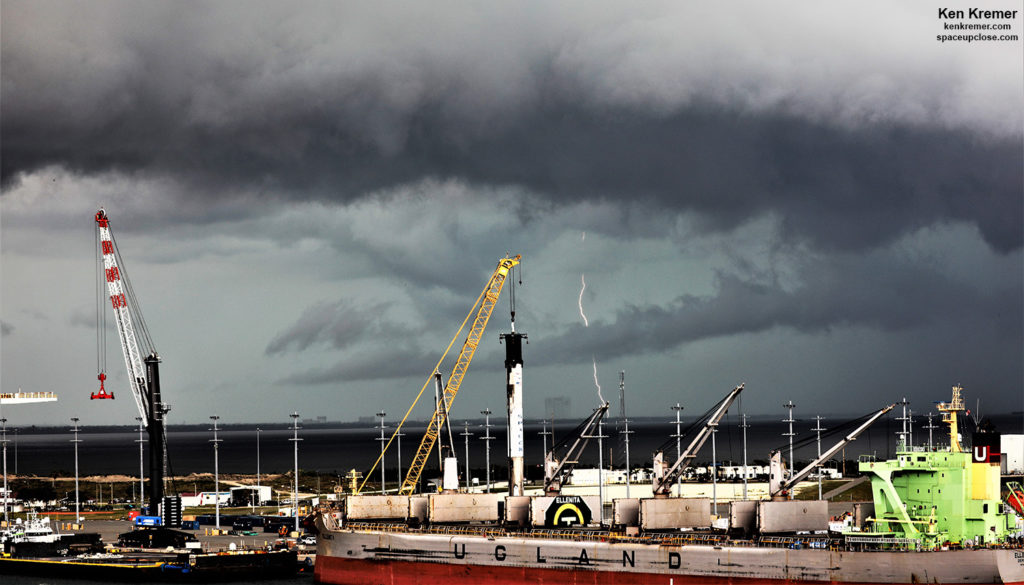Kremer — SpaceUpClose.com &
RocketSTEM – 8 May 2019
PORT
CANAVERAL, FL- All 4 landing legs on the newest ‘flight-proven’ and sea recovered
Falcon 9 first stage remained fully retracted and locked in place flush with
the core for the first time today, Wednesday, May 8 – rather than being removed
and dissected off by SpaceX technicians working at Port Canaveral for transport
back to the Cape – thereby marking a significant milestone towards cutting booster recycling
time for the upgraded Block 5 version of the booster, as outlined last year by billionaire
CEO Elon Musk.
Glistening
gloriously with a serene sunset sheen the 15 story tall SpaceX Falcon 9 launched
and landed booster from NASA’s Dragon CRS-17 resupply mission to the ISS on May
4 made for a truly remarkable sight at the end of a long work day yesterday,
Tuesday, May 7.
In
fact the erect Falcon 9 with 4 retracted legs on a pedestal appeared as though
it was awaiting blastoff – minus the second stage and payload fairing.
That effort
saw a team of perhaps two dozen SpaceX technicians and crane workers methodically
retract all four landing legs one by one using the hi tech hoisting device we informally
name the BLLRD – or Booster Lift and Leg Retraction Device.
Enjoy
our Space UpClose gallery of imagery documenting all the action from onsite at
Port Canaveral, to closely observe all the action from across the narrow
channel as best as possible.
it took the SpaceX team nearly 4.5 hours to raise the 4 legs and keep them stowed
against the core stage on May 7 – starting around 2 p.m. EDT and concluding at
nearly 6:30 p.m.
all this retraction work only came a full two days after the booster was carefully
craned off the ‘Of Course I Still Love You’
(OCISLY) droneship around 11 a.m. EDT Sunday, May 5 – upon which it had successfully
soft landed Saturday, May 4 around 3 a.m.
The 156 foot tall craned
stage was mounted vertically on the same pedestal and cradle used in the past
by SpaceX crews at the berthing port beside OCISLY.
Thus the day when SpaceX
can actually achieve a 24 hour landing-to-launch turnaround is still a ways off
in the future. However, this mission represents clear progress towards Musk’s
goal of rapid reusability.
“One of the biggest reusability improvements
was fast leg stow. Version 1 sometimes took days,” Musk tweeted during the process.
Upon the
successful introduction of the significantly upgraded Block 5 version of the
Falcon 9 exactly 1 year ago in May 2019 SpaceX CEO Musk said the landing legs would all be retracted
as one of the key requirements toward achieving rapid rocket turnaround for recycled
booster launches.
So it was surprising
when that tuned out not to be the case for the first few recovered Block 5
boosters last year.
This CRS-17 landed
booster was towed into Port Canaveral late Saturday, May 4, after a few hours delay
due to atrocious rains squall, thunder and a pair of cruise ship departures.
See our separate photo story.
The SpaceX
designed BLLRD is a round cap surrounded by a square solar powered skeletal cage
that crane workers install onto the top of the open core stage that then locks
in place. The cage is equipped with long cables on pulleys that are lowered to
the legs and counterweights.
Prior
to the leg retraction operation the strut from at least one leg was dissembled
as the workers took pains to unload an interior piston and possibly lubricated
the interior.
During
the final moments of the landing operation the four legs deploy by gravity and
hydraulically and lock in place to
keep the booster upright. They cannot retract
back up on their own.
Each
leg raising procedure took roughly an hour and appeared to go well with few
interruptions or pauses.
As the
teams moved from one leg to the next they manually fastened a perpendicular metallic
rod to the end of each landing pad at a special attachment joint. They attached cables at each end of the rod leading
to the BLLRD cage 15 stories above.
The
rod and cables were then manually detached, moved and reattached in quick
succession.
During
past retraction attempts last year the landing legs were pulled up in fits and
starts with frequent interruptions. Occasionally
the legs had to be partially lowered again as the team appeared to encounter holdups
and sticking joints before resuming to complete the retractions.
And
then in each case the technicians simply reversed course, dropped the legs back
down and fully detached each one – abandoning any retraction progress made.
The landing
legs each weigh about 600 kg (1300 lb) and measure about 10 meters (33 feet) long.
In
fact the retractions proved to be so unwieldy and unproductive that SpaceX
abandoned retraction attempts for the prior three missions while they worked on
redesigning the process.
The CRS-17 booster model
B1046 had safely touched down on OCISLY some eight minutes after launch May 4
at a spot located just a few miles offshore of the Florida Space Coast beaches
for the first time ever.
The dramatic propulsive pinpoint
and upright first stage soft landing intact was easily visible given the
crystal clear night time skies under superb weather conditions.
about 213-feet (65-meters) tall.
is tentatively targeted for May 15 at 10:30 p.m. EDT.
and Crew Dragon mission in lead video:
 |
|
Dr Ken Kremer/Space UpClose interviewed about SpaceX
mission on CBS Orlando TV News station WKMG by reporter James Sparvero |
Watch my commentary at Fox 35 TV News Orlando about the SpaceX
Crew Dragon testing failure here and the implications for delay in future Crew
Dragon test flights here:
http://www.fox35orlando.com/news/local-news/spacex-capsule-that-is-expected-to-be-the-future-of-manned-missions-suffers-an-explosion
Watch for Ken’s continuing
onsite coverage of NASA, SpaceX, ULA, Boeing, Lockheed Martin, Northrop Grumman
and more space and mission reports direct from the Kennedy Space Center, Cape
Canaveral Air Force Station, Florida and Wallops Flight Facility, Virginia.
Stay tuned here for Ken’s continuing Earth and
Planetary science and human spaceflight news: www.kenkremer.com –www.spaceupclose.com – twitter @ken_kremer
– email: ken at kenkremer.com
Dr. Kremer is a research scientist and journalist based in the
KSC area, active in outreach and interviewed regularly on TV and radio about
space topics.
………….
Ken’s photos are for sale and he is available for lectures and outreach events


